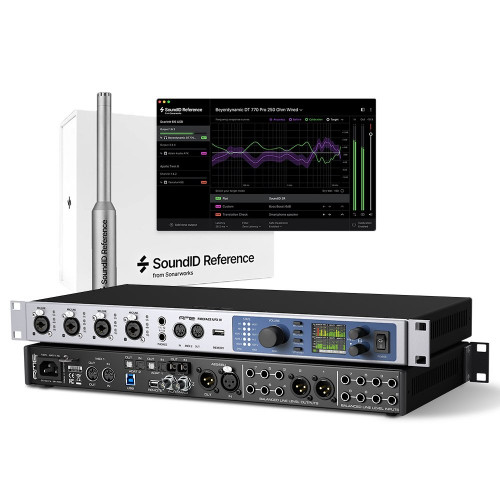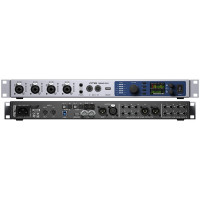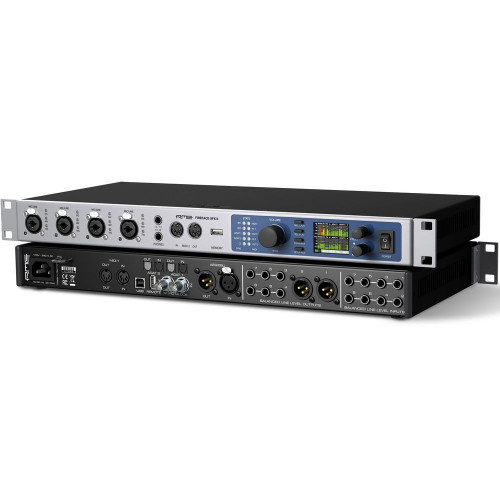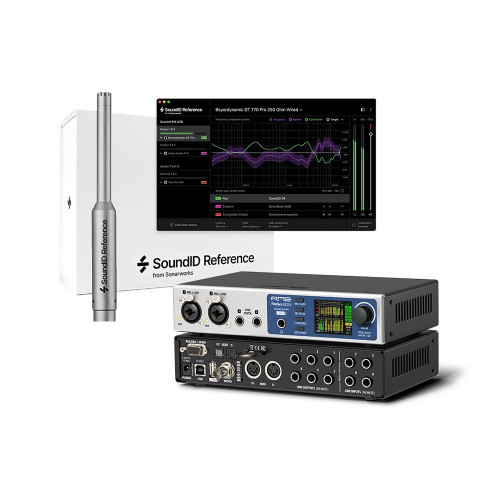RME Fireface UFX III + Sonarworks Multichannel Bundle
Buy an RME Fireface UFX III and Sonarworks SoundID Reference together as a bundle.
Includes the following:
- 1 x RME Fireface UFX III
- 1 x Sonarworks SoundID Reference (Multichannel) Licence
- 1 x Sonarworks Calibrated Measurement Microphone
- Free Shipping!
Description
RME Fireface UFX III + Sonarworks Bundle
Ready to take your mixes to the next level?
Now you can purchase the incredible RME Fireface UFX III together with Sonarworks SoundID Reference for Multichannel software – complete with a calibrated measurement microphone!
Once you've exported your SoundID profile from Sonarworks' award-winning room correction software, you'll be able to load it directly into RME’s advanced Room EQ feature.
Elevate your audio experience like never before with precise Room Calibration tools on up to 20 audio channels - 9-band PEQ, Delay, Volume Calibration and Crossfeed - all powered by your RME audio interface’s on-board DSP (so zero added strain on your Mac or PC!).

Whether you’re working in Stereo, Surround or Immersive Audio formats, say goodbye to unwanted resonances and hello to your new finely-calibrated monitoring environment.
Note: We are the official UK distributor for RME Audio. This is a UK-only initiative fulfilled by us (Synthax Audio UK), and is open to UK residents only. You must have a UK delivery address to take advantage of this deal.
The Flagship Multi-channel Interface
The Fireface UFX III is a powerful all-in-one solution for modern recording studios, live audio playback systems and multi-channel location recording rigs, handling up to 188 channels (94 Inputs / 94 Outputs) with ease.
Unprecedented flexibility and compatibility combines with RME’s famous low latency hardware and driver designs, guaranteeing flawless operation for any multi-channel recording application, whilst the inclusion of DURec (Direct USB Recording) provides extensive options for backup recordings and stand-alone operation.
The ultimate professional tool for multi-track recording, mixing and mastering, the RME Fireface UFX III is packed with professional features including:
- USB 3.0 (full 94 channel I/O Class Compliant; USB-C compatible)
- SteadyClock FS
- Powerful integrated DSP
- TotalMix FX
- TotalMix Remote
- DURec (Direct USB Recording)
- MADI I/O (64 channels)
- And support for the Advanced Remote Control USB (sold separately)

click image to enlarge
Connectivity & Features

click image to enlarge
Powerful USB 3 Performance
The front panel of the Fireface UFX III provides four high-performance XLR/TRS combo inputs for microphone, instrument and line signals, two stereo headphone jacks with +19 dBu output level, MIDI I/O, and a USB port.
In combination with the DURec function (Direct USB Recording), the USB port allows independent recording of selected input and output signals (up to 80 channels) to a connected USB storage medium.
The rear panel reveals the full connectivity of the Fireface UFX III. Besides another MIDI I/O, the two optical ADAT I/Os, an AES/EBU I/O, and eight balanced analogue outputs with line level (including XLR stereo monitor outputs) are available.
With the new Multi-Mode, the two ADAT I/Os can be used as separate optical SPDIF inputs and outputs in addition to the AES I/O. Furthermore, the Fireface UFX III offers an optical MADI interface (SC) with 64 bidirectional channels. The Word Clock connectors (BNC) work as additional coaxial MADI input and output if required.

TotalMix FX, TotalMix Remote, DIGICheck & always up-to-date drivers
Comprehensive MADI Connectivity
The Fireface UFX III opens the doors to a host of RME and 3rd party digital and analogue I/O solutions.
Expanding your analogue channel count, the ability to route/mix within the digital domain through numerous sources presents many flexible options. Multiple external MADI devices can also be connected in series.
To further enhance MADI flexibility, the Fireface UFX III boasts some typical RME-style features. For example in USB 2 mode, which is limited to 30 channels I/O (12 analogue plus 16 ADAT plus AES), the MADI I/O is still available via RME’s integrated hardware mixer TotalMix FX.
Word Clock I/O (BNC) can be switched to MADI I/O (coaxial), and a special split mode even supports the use of both MADI I/Os simultaneously, with 32 channel each on optical and coaxial.

Unrivalled flexibility in connectivity and expansion – Analogue, ADAT, MADI, AES, SPDIF, USB 2 & USB 3
SteadyClock FS - FemtoSecond Clocking Technology
The RME Fireface UFX III also features RME's latest digital clocking and jitter rejection technology, 'SteadyClock FS'.
Originally developed for RME's award-winning ADI-2 Pro FS range of high-end converters, SteadyClock FS reduces intrinsic jitter to a new all-time low, when converting to and from analogue over all digital formats.
All clock modes provide excellent performance and astonishingly high-quality analogue conversion, allowing you to hear your mix exactly as it is.
What's more, RME's digital format conversion occurs without any loss to the signal, and SteadyClock FS ensures your sonic image will never experience any kind of degradation, ensuring the soundstage is replicated to the fullest depth and clarity.

Pristine signal conversion and sample accuracy with SteadyClock FS
Included Accessories:
- Cable USB 3.0, 1.8 m (6 ft), USB-A/B
- Cable USB 3.0, 1.8 m (6 ft), USB-C/B
- Optical cable
- 4 rubber feet, self-adhesive
- Power cable
- Printed Manual
See more videos at Synthax TV
Powerful Applications for Mixing, Monitoring and Measurement included
The Fireface UFX III comes with the TotalMix FX DSP mixer, offering comprehensive routing and monitoring options for all analogue and digital audio channels, as well as the DIGICheck Analyzer, which allows users to measure and analyze digital audio data feeds (in both directions) with maximum precision.

click image to enlarge
TotalMix FX can completely replace an external mixer, enabling the creation of multiple latency-free monitor mixes with EQ, Dynamics, Reverb and Delay for any outputs, including main monitors, submixes, and headphone mixes for musicians.
A free companion app, TotalMix Remote is a network-controllable remote for TotalMix FX, enabling control over interface's hardware mixer and effects from another Mac, PC or iPad, including wirelessly over Wi-Fi.
TotalMix Remote mirrors the current state of the host system on the iPad and Windows/Mac computers - the entire mixing state, the complete routing, all FX settings, up to the level meters, and everything in real time.
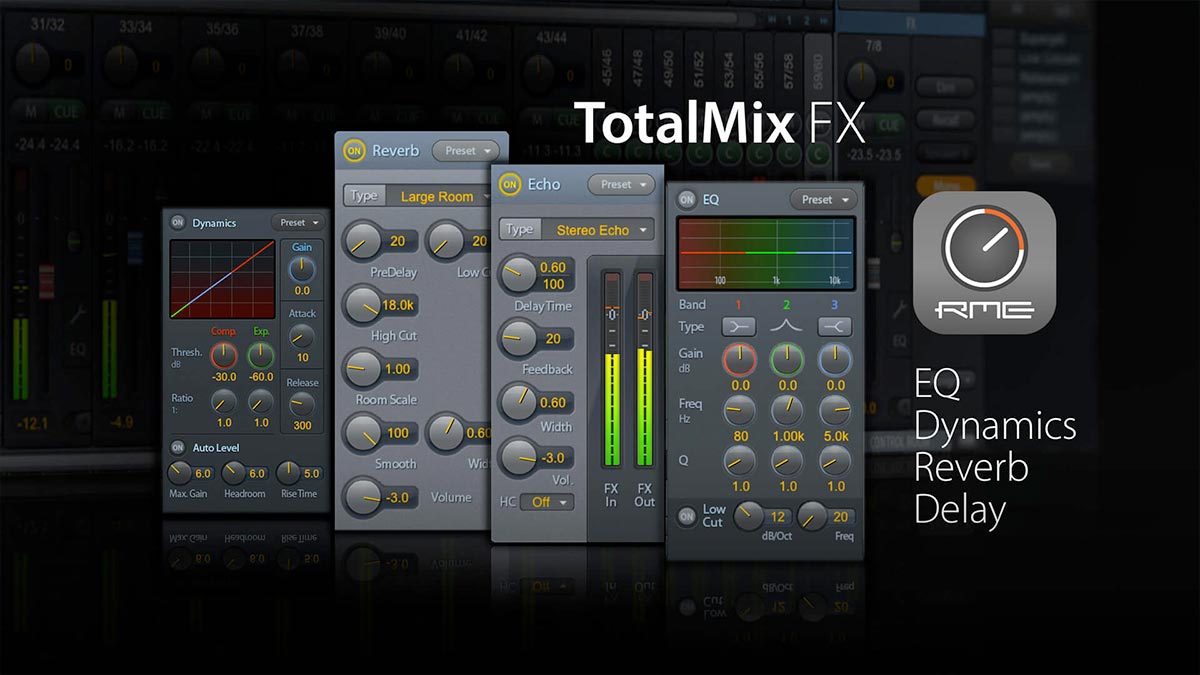
TotalMix FX mixer with comprehensive routing, monitoring and effects options
DC-Coupled Outputs - CV/Gate Voltage Control
Most audio interfaces are traditionally designed with what is called 'AC-coupled outputs', where capacitors are used to filter out any extreme low frequencies.
Whilst these frequencies are generally considered undesirable for audio - eating into headroom and potentially causing damage to other equipment - one instance where DC-coupling remains desirable is the world of modular synthesizers, where static or slow-moving signals are used for control over various parameters such as pitch note values or LFOs.
All of the Fireface UFX III’s line-level outputs are fully DC-coupled, allowing for the sending of control voltages (CV) or Gate information to modular synthesizers (such as the popular Eurorack and Moog/MOTM/Synthesizers formats) and other studio hardware.

Control all device states directly from the front panel for convenient, direct access to all features.
USB 3 Class Compliant Audio
The Fireface UFX III operates in two different modes: driver-based and Class Compliant.
Class Compliant mode is a standard that is natively supported by operating systems like Windows, Mac OSX and Linux distributions, allowing for Plug 'n' Play operation of the Fireface UFX III. No proprietary drivers are required, the device will be directly recognised when the CC firmware is loaded.
The Fireface UFX III is RME's first audio interface with full USB 3.0 support in Class Compliant Mode. This makes all channels available in driverless operation for Linux, Mac and iPadOS.
An iPad Pro with USB-C can manage up to 94 channels for recording and playback in TotalMix FX for iPad and on system level.

TotalMix FX mixer with comprehensive routing, monitoring and effects options
ARC USB Remote Control
The ARC USB is an optional remote control for the Fireface UFX III, along with all other RME devices that use TotalMix FX.
15 user-assignable illuminated buttons, one encoder wheel, and a TS jack (for connecting a foot switch) provide access to all of the most used functions of TotalMix FX.
The ARC USB can be connected directly to the Fireface UFX III via the second USB port on the back of the interface, or directly to a USB port on a Mac or PC.
Operating as a UAC 1 class device, the RME ARC USB is natively compatible with Windows and Mac OS X. As soon as it is present in the operating system, TotaIMix FX will automatically detect the ARC USB, and communicate with it via simple MIDI remote commands to control the UFX III.
Find out more about the RME ARC USB

Optional monitoring and TotalMix controller - RME ARC USB
DURec (Direct USB Recording)
DURec is an integrated digital recorder for all inputs and outputs directly to USB memory devices via the front USB port. The Fireface UFX III records on USB thumb drives or hard drives with up to 2 TB capacity.
The recording functionality is provided by the internal DSP, and is therefore independent from a connected Windows or Mac computer. The Direct USB Recording converts the Fireface UFX Series both into a stand-alone field recorder and a powerful multichannel live player for previous recordings, e. g. for virtual sound checks.
Live concerts, band rehearsals or spontaneous jam sessions can be directly recorded and played back from the medium - even completely stand-alone without computer or software.

RME DURec - Record directly to USB Thumb Drives & External HDs
Specification
General
- Power supply: Internal switching PSU, 100 - 240 V AC, 36 Watts
- Idle power consumption: 19 Watts
- Typical power consumption: 22-25 Watts
- Dimensions including rack ears (WxHxD): 483 x 44 x 210 mm (19" x 1.73" x 8.5")
- Dimensions without rack ears (WxHxD): 440 x 44 x 210 mm (17.3" x 1.73" x 8.3")
- Total depth: 240 mm (9.4”)
- Weight: 3 kg ( 6.6 lbs)
- Temperature range: +5° up to +50° Celsius (41° F up to 122°F)
- Relative humidity: < 75%, non condensing
Analogue
AD, Line In 1-8, rear
- Input: 6.3 mm TRS, electronically balanced
- Signal to Noise ratio (SNR) @ LoGain: 116 dB (AES17), 118 dBA
- Signal to Noise ratio (SNR) @ +4 dBu: 115 dB (AES17), 117 dBA
- Frequency response @ 44.1 kHz, -0.1 dB: 8.9 Hz – 20.4 kHz
- Frequency response @ 96 kHz, -0.5 dB: 4.3 Hz – 45.2 kHz
- Frequency response @ 192 kHz, -1 dB: 3 Hz – 89 kHz
- Filter: Short Delay Sharp, 5 / 5 / 6 samples delay
- THD @ -1 dBFS: < -120 dB, < 0.0001 %
- THD+N @ -1 dBFS: < -110 dB, < 0.00032 %
- Channel separation: > 110 dB
- Maximum input level: +19 dBu
- Input: 6.3 mm TRS jack, electronically balanced
- Input impedance @ 1 kHz: 10 kOhm unbalanced, 10.6 kOhm balanced
- Input sensitivity switchable between Lo Gain and +4 dBu
- Input level for 0 dBFS @ Lo Gain: +19 dBu
- Input level for 0 dBFS @ +4 dBu: +13 dBu
- Variable digital gain: 0 to +12 dB
- Minimum level for 0 dBFS: +1 dBu, -1.2 dBV
Microphone In 9-12, front
As AD, but:
- Input: XLR, electronically balanced
- Input impedance @ 1 kHz: 3.4 kOhm
- Signal to Noise ratio (SNR) @ 0 dB Gain: 117 dB (AES17), 119.5 dBA
- THD+N @ -1 dBFS, Gain 20 dB: < -110 dB, < 0.00032 %
- Frequency response @ 44.1 kHz, -0.1 dB: 10.7 Hz – 20.3 kHz
- Frequency response @ 96 kHz, -0.5 dB: 5.1 Hz – 45.0 kHz
- Frequency response @ 192 kHz, -1 dB: 3.5 Hz – 88 kHz
- EIN @ 60 dB Gain, 150 Ohm, A-Weighted: -129.8 dBu
- Gain range: 75 dB
- Maximum input level, Gain 0 dB: +18 dBu
- Maximum input level, Gain 75 dB: -57 dBu
- CLIP LED: 0 dBFS
- SIG LED: -60 dBFS
Instrument In 9-12, front
As AD, but:
- Input: 6.3 mm TS jack, unbalanced
- Input impedance @ 1 kHz: 1 MOhm
- Signal to Noise ratio (SNR): 116 dB (AES17), 118.5 dBA
- Frequency response @ 44.1 kHz, -0.5 dB: 2.4 Hz – 20.0 kHz
- Frequency response @ 96 kHz, -1 dB: 1.6 Hz – 28 kHz
- Frequency response @ 192 kHz, -3 dB: 0.8 Hz – 54 kHz
- THD+N @ -1 dBFS, Gain 20 dB: < -107 dB, < 0.00045 %
- Gain range: 42 dB
- Maximum input level, Gain 8 dB: +21 dBu
- Maximum input level, Gain 50 dB: -21 dBu
DA, Line Out 3-8, rear
- Output: 6.3 mm TRS jack, servo-balanced
- Signal to Noise ratio (SNR) @ HiGain: 116.5 dB (AES17), 118.5 dBA
- Signal to Noise ratio (SNR) @ +4 dBu: 116 dB (AES17), 118 dBA
- Signal to Noise ratio (SNR) @ -10 dBV: 107 dB (AES17), 109 dBA
- Frequency response @ 44.1 kHz, -0.1 dB: 0 Hz – 20.2 kHz
- Frequency response @ 96 kHz, -0.5 dB: 0 Hz – 44.6 kHz
- Frequency response @ 192 kHz, -1 dB: 0 Hz – 77.5 kHz
- THD+N: < -110 dB, < 0.00032 %
- Channel separation: > 110 dB
- Output level switchable Hi Gain, +4 dBu, -10 dBV
- Output level at 0 dBFS @ Hi Gain: +19 dBu
- Output level at 0 dBFS @ +4 dBu: +13 dBu
- Output level at 0 dBFS @ -10 dBV: +2 dBV (+4.2 dBu)
- Output impedance: 75 Ohm
DA - Stereo Monitor Output XLR (1-2)
As DA, but:
- Output: XLR, balanced
- Output level switchable 24 dBu, Hi Gain, +4 dBu, -10 dBV
- Output level at 0 dBFS @ 24 dBu: +24 dBu
- Output level at 0 dBFS @ Hi Gain: +19 dBu
- Output level at 0 dBFS @ +4 dBu: +13 dBu
- Output level at 0 dBFS @ -10 dBV: +2 dBV (+4.2 dBu)
- Output impedance: 150 Ohm
DA - Stereo Monitor Output Phones (9-12)
As DA, but:
- Output: 2 x 6.3 mm TRS stereo jack, unbalanced
- Maximum output level at 0 dBFS, High: +19 dBu
- Maximum output level at 0 dBFS, Low: +2 dBV
- Max power per channel @ 32 Ohm load, 0.02% THD: 200 mW (2.5 Vrms, +10 dBu)
- Signal to Noise ratio (SNR) @ High: 116.5 dB (AES17), 118.5 dBA
- Signal to Noise ratio (SNR) @ Low: 115 dB (AES17), 117 dBA
- Output impedance: 2 Ohm
MIDI
- 2 x MIDI I/O via 5-pin DIN jacks
- Galvanically isolated by optocoupled input
- Hi-speed mode: Jitter and response time typically below 1 ms
- Separate 128 byte FIFOs for input and output
- 1 x MIDI I/O via MADI
- Invisible transmission via User bit of channel 56 (up to 48 kHz)
- Invisible transmission via User bit of channel 28 (up to 96 kHz)
Digital
- Clocks: Internal, ADAT, AES, SPDIF, word clock
- Jitter suppression: > 50 dB (> 1 Hz)
- Effective clock jitter influence on AD and DA conversion: near zero
- PLL ensures zero dropout, even at more than 100 ns jitter
- Digital Bitclock PLL for trouble-free varispeed ADAT operation
- Supported sample rates: 28 kHz up to 200 kHz
Digital Inputs
MADI
- Optical via FDDI duplex SC connector
- 62.5/125 and 50/125 compatible
- Coaxial via BNC (Word Clock input), 75 Ohm
- High-sensitivity input stage (< 0.2 Vpp)
- Accepts 56 channel and 64 channel mode, plus 96k Frame
- Standard: up to 64 channels 24 bit 48 kHz
- S/MUX: up to 32 channels 24 bit 96 kHz
- S/MUX4: up to 16 channels 24 bit 192 kHz
- Lock range: 25 kHz – 54 kHz
- Jitter suppression: > 50 dB (> 1 Hz)
AES/EBU
- 1 x XLR, transformer-balanced, galvanically isolated, according to AES3-1992
- High-sensitivity input stage (< 0.3 Vpp)
- SPDIF compatible (IEC 60958)
- Accepts Consumer and Professional format
- Lock range: 27 kHz – 200 kHz
- Jitter suppression: > 50 dB (> 1 Hz)
ADAT Optical
- 2 x TOSLINK, format according to Alesis specification
- Standard: 8 channels 24 bit, up to 48 kHz
- Double Speed (S/MUX): 4 channels 24 bit 96 kHz
- Quad Speed (S/MUX4): 2 channels 24 bit 192 kHz
- Bitclock PLL ensures perfect synchronisation even in varispeed operation
- Lock range: 31.5 kHz – 50 kHz
- Jitter suppression: > 50 dB (> 1 Hz)
SPDIF optical (ADAT 2)
- 1 x optical, according to IEC 60958
- Accepts Consumer and Professional format
- Lock range: 27 kHz – 200 kHz
- Jitter suppression: > 50 dB (> 1 Hz)
Word Clock
- BNC
- Internal termination 75 Ohm switchable
- Automatic Double/Quad Speed detection and internal conversion to Single Speed
- SteadyClock guarantees super low jitter synchronization even in varispeed operation
- Not affected by DC-offsets within the network
- Signal Adaptation Circuit: signal refresh through auto-center and hysteresis
- Overvoltage protection
- Level range: 1.0 Vpp – 5.6 Vpp
- Lock Range: 27 kHz – 200 kHz
- Jitter suppression: > 50 dB (> 1 Hz)
Digital Outputs
MADI
- Optical via FDDI duplex SC connector
- 62.5/125 and 50/125 compatible
- Coaxial via BNC (Word Clock input), 75 Ohm
- High-sensitivity input stage (< 0.2 Vpp)
- Accepts 56 channel and 64 channel mode, plus 96k Frame
- Standard: up to 64 channels 24 bit 48 kHz
- S/MUX: up to 32 channels 24 bit 96 kHz
- S/MUX4: up to 16 channels 24 bit 192 kHz
- Lock range: 25 kHz – 54 kHz
- Jitter suppression: > 50 dB (> 1 Hz)
AES/EBU
- XLR, transformer-balanced, galvanically isolated, according to AES3-1992
- Output level Professional 4.5 Vpp, Consumer 2.6 Vpp
- Format Professional according to AES3-1992 Amendment 4
- Format Consumer (SPDIF) according to IEC 60958
- Single Wire mode, sample rate 28 kHz up to 200 kHz
ADAT
- 1 x TOSLINK, format according to Alesis specification
- Standard: 8 channels 24 bit, up to 48 kHz
- Double Speed (S/MUX): 4 channels 24 bit 96 kHz
- Quad Speed (S/MUX4): 2 channels 24 bit 192 kHz
SPDIF optical (ADAT 2)
- 1 x optical, according to IEC 60958
- Accepts Consumer and Professional format
- Lock range: 27 kHz – 200 kHz
- Jitter suppression: > 50 dB (> 1 Hz)
Word Clock
- BNC
- Max. output voltage: 5 Vpp
- Output voltage @ 75 Ohm termination: 4.0 Vpp
- Output impedance: 10 Ohm
- Frequency range: 27 kHz – 200 kHz
Customer Reviews
This item currently has no reviews.






















